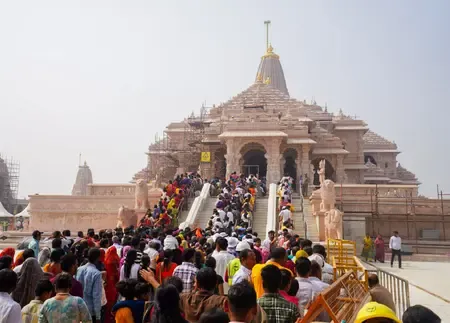What is the Significance of Ram Temple's Sapt Mandir?

Synopsis
Key Takeaways
- Seven temples honoring significant figures in Lord Ram's life.
- Prominent figures include Maharishi Vashistha, Vishwamitra, and Valmiki.
- Each figure's story is tied to Lord Ram's journey.
- The Sapt Mandir emphasizes the importance of devotion and guidance in spirituality.
- Prime Minister Modi's visit highlights national significance.
Ayodhya, Nov 25 (NationPress) Prime Minister Narendra Modi visited the Sapt Mandir situated within the vast Ram Janmabhoomi Temple complex in Ayodhya on Tuesday, offering his prayers.
This sacred site comprises seven temples dedicated to Maharishi Vashistha, Maharishi Vishwamitra, Maharishi Agastya, Maharishi Valmiki, Goddess Ahalya, Nishadraj Guha, and Mata Shabari.
The Sapt Mandirs honor these esteemed gurus, devotees, and companions who played vital roles in Lord Ram’s journey, emphasizing their lasting importance in the narrative.
Maharishi Vashistha:
Revered as the royal guru of Lord Ram, Maharishi Vashistha is believed to be the mind-born son of Lord Brahma. His profound wisdom and ascetic strength were instrumental in teaching Lord Ram the Vedas and guiding King Dasharatha in critical moments.
Maharishi Vishwamitra:
Originally a Kshatriya, Maharishi Vishwamitra became a Brahmarishi through rigorous penance and taught Ram and Lakshman the arts of weaponry and divine warfare. Under his mentorship, they triumphed over various demons, leading to their participation in Sita’s swayamvara, where Ram famously broke Shiva’s bow.
Agastya Muni:
During his fourteen-year exile, Lord Ram encountered Agastya Muni, who equipped him with divine weapons necessary for the battle against Ravan. Agastya gifted Ram a formidable bow, arrows, a sword, and impenetrable armor, guiding him towards victory over Lanka.
Maharishi Valmiki:
The Ramayana is closely tied to Maharishi Valmiki, the epic's author. Post-Ram's coronation, Sita took refuge in Valmiki's ashram, where she gave birth to Luv and Kush, who were trained by him in scriptures and martial skills.
Goddess Ahalya:
Goddess Ahalya’s story is one of the most touching in the Ramayana. Cursed by Gautama Rishi to become stone after being deceived by Indra, she regained her humanity when Ram’s feet graced the stone. Her tale symbolizes redemption and divine grace.
Kevat Nishadraj Guha:
Another pivotal character, Kevat Nishadraj Guha, ferried Ram, Sita, and Lakshman across the Ganga. Before the crossing, he washed Ram’s feet, expressing concern that his boat might transform into a woman like Ahalya. He declined any payment, asking Ram instead for help in navigating the ocean of life. Guha became one of Ram's closest allies.
Mata Shabari:
Mata Shabari’s unwavering devotion symbolizes unconditional love. Aware of Ram’s impending visit during his exile, she collected sweet berries for him, tasting each one to ensure only the finest reached him. While Ram accepted her offerings with love, Lakshman dismissed them, believing they were stale. Ram recognized Shabari's pure devotion, which had guided her life.
Prime Minister Modi’s visit to the Sapt Mandir was a heartfelt tribute to these timeless figures whose lives shaped the divine narrative of Lord Ram and continue to inspire millions.









